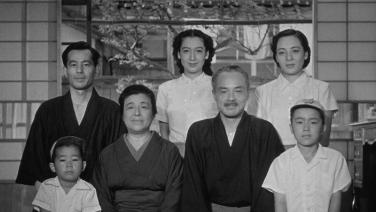
19:00 Presentation by Santos Zunzunegui
20:00 Bakushu (Early Summer), Yasujiro Ozu, Japan, 1951, 130 minutes
Kamakura, during the immediate postwar period, after the defeat of Japan in 1945. The Mamiya family, made up of three generations who live together in the same house, are getting ready for the visit of Uncle Mokichi who is arriving from distant Yamato, their region of origin. The grandparents, Shukichi (Ichiro Sugai) and Shige (Chieko Higashimaya), had three children. The middle child, Shoji, disappeared in the war. The eldest son, Koichi (Chishu Ryu), works as a doctor in Tokyo, is married to Fumiko (Kuniko Miyake) and is the father of two unruly kids, Minoru and Isamu. And the little sister, Noriko (Setsuko Hara) works as a clerk in the same city.
But Noriko is a worry for her older brother and her parents: she has reached the age of twenty-eight and does not seem to show any interest in getting married. Her boss, who shares the family’s concern, suggests what he describes as a perfect candidate for the young woman: a mature businessman in his forties who belongs to an important family. But Noriko shows no interest at all in the proposal, despite the approval of her parents and brother.
One day, after an argument with their father, Minoru and Isamu escape from home. Noriko requests the help of a neighbour, Kenkichi Yabe, a young widower with a daughter who works as a doctor for her brother Koichi and who was a close friend of the missing Shoji.
And life continues: the kids have returned home and Yabe is appointed head of the medical service in the north of the country, in distant Akita. Shortly before he leaves, Yabe and Noriko go out together and remember the brother who disappeared in the war. Noriko visits Yabe’s mother (Harako Sugimura) while the young man packs his things for the journey. The old woman impulsively confesses to Noriko that she always saw her as the ideal wife for her son. The young woman’s response is surprising: she would accept such a proposal without hesitation. There and then they agree on the marriage, although Yabe does not seem very enthusiastic about the idea.
In Noriko’s family, the news is not well received, especially by her older brother, who regards the decision a purely impulsive act. But Noriko is resolute in her decision. Noriko says goodbye to her boss and her friend Aya (Chikage Awajima) and just before the farewell dinner the family group poses for the ritual photo that will bring together the entire Mamiya family perhaps for the last time.
Without Noriko’s salary, who leaves for Akita with her husband, the group has to reconstruct itself. Koichi will set up his own medical practice in Kamakura and the parents will go to a village in Yamato to live in Uncle Mokichi’s house.
Some time has passed. The two elderly parents watch a wedding procession go by in the distance. It is clear that they are reminded of their daughter. But the acceptance of life as it is, of change as the immutable rule of nature, leads them to acknowledge that life has allowed them to do many things together and that it would be wrong to ask for too much.
The sublime final shot (a truly characteristic piece of Ozu cinematography) closes the film in an exemplary way: An establishing shot shows the rounded shape of a hill covered with vegetation. In the foreground, and occupying the exact lower half of the frame, is a field of barley – referred to in the original title of the film – whose ears are moving in the wind. The houses of the village form a diffuse line that frames the mountain and the sea of cereal. A panning shot, from left to right, is carried out in such a way that, by reframing, the limits of the image are preserved.
We are presented with a shot which figuratively captures the ideas of the permanent and the changing, the immobile and the mobile, embodied in the mountain and the ears of barley swayed by the wind whose invisibility is made visible precisely by this movement of the plants. While the foreground in the image – the field of barley – flows, the background – the hill – remains emphatically static. The same idea is also repeated in the cinematographic projection of the image. In fact, although the camera moves, its movement is practically imperceptible due to the insistence on the part of the film-maker on the constant maintenance of the lateral edges of the frame. In this way, in the same image, opposing elements are reconciled, agreement is reached between contradictory positions, and the dialectic between ideas and the tangible world is solved harmonically through the extreme refining of forms. At the moment of truth, Ozu seems to suggest that the tangible and the intelligible cannot be separated. The spirit only dwells in the things of the world.
Kamakura, during the immediate postwar period, after the defeat of Japan in 1945. The Mamiya family, made up of three generations who live together in the same house, are getting ready for the visit of Uncle Mokichi who is arriving from distant Yamato, their region of origin.
